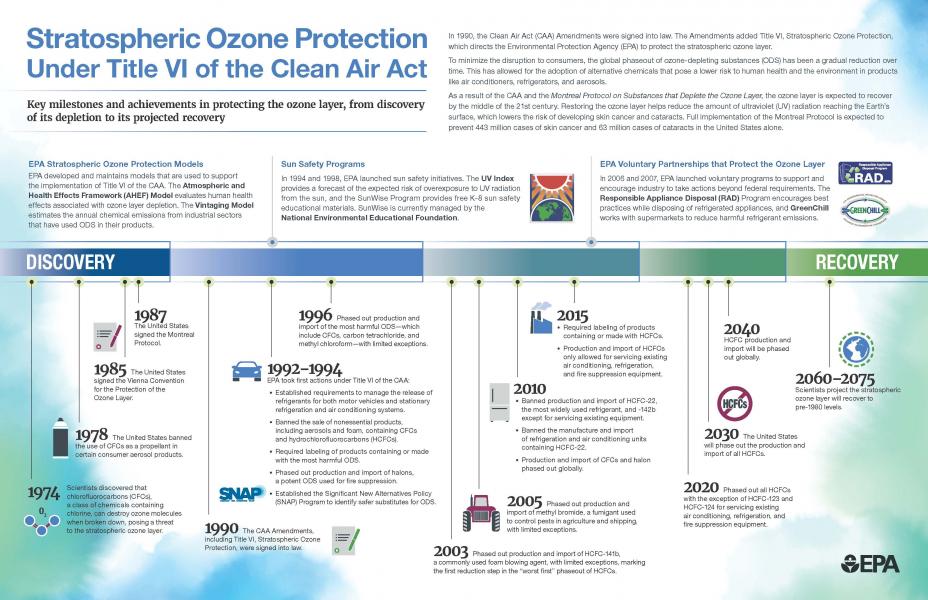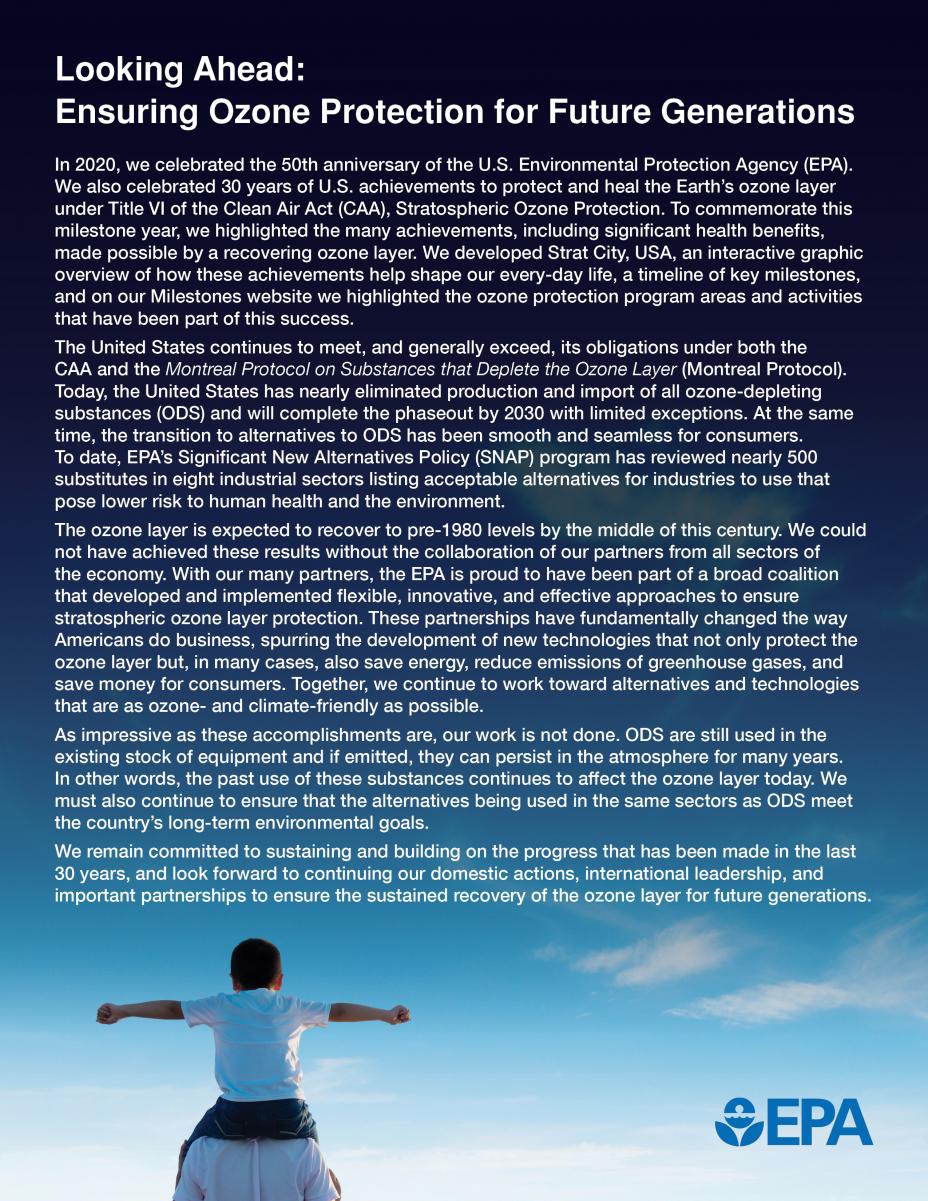Ozone Layer Protection Milestones of the Clean Air Act
During this past year, we celebrated the 50th anniversary of the U.S. Environmental Protection Agency (EPA). This year we also celebrated 30 years of U.S. achievements to protect and heal the Earth’s ozone layer under Title VI of the Clean Air Act (CAA), Stratospheric Ozone Protection. To commemorate this milestone year, we highlighted the many achievements, including significant health benefits, made possible by a recovering ozone layer. We developed Strat City, USA, an interactive graphic overview of how these achievements help shape our every-day life, a timeline of key milestones, and on our Milestones website we highlighted the ozone protection program areas and activities that have been part of this success.
The United States continues to meet, and generally exceed, its obligations under both the CAA and the Montreal Protocol on Substances that Deplete the Ozone Layer (Montreal Protocol). Today, the United States has nearly eliminated production and import of all ozone-depleting substances (ODS) and will complete the phaseout by 2030 with limited exceptions. At the same time, the transition to alternatives to ODS has been smooth and seamless for consumers. To date, EPA’s Significant New Alternatives Policy (SNAP) program has reviewed nearly 500 substitutes in eight industrial sectors listing acceptable alternatives for industries to use that pose lower risk to human health and the environment.
The ozone layer is expected to recover to pre-1980 levels by the middle of this century. We could not have achieved these results without the collaboration of our partners from all sectors of the economy. With our many partners, the EPA is proud to have been part of a broad coalition that developed and implemented flexible, innovative, and effective approaches to ensure stratospheric ozone layer protection. These partnerships have fundamentally changed the way Americans do business, spurring the development of new technologies that not only protect the ozone layer but, in many cases, also save energy, reduce emissions of greenhouse gases, and save money for consumers. Together, we continue to work toward alternatives and technologies that are as ozone- and climate-friendly as possible.
As impressive as these accomplishments are, our work is not done. ODS are still used in the existing stock of equipment and if emitted, they can persist in the atmosphere for many years. In other words, the past use of these substances continues to affect the ozone layer today. We must also continue to ensure that the alternatives being used in the same sectors as ODS meet the country’s long-term environmental goals.
Looking forward, we remain committed to sustaining and building on the progress that has been made in the 30 years, and look forward to continuing our domestic actions, international leadership, and important partnerships to ensure the sustained recovery of the ozone layer for future generations.
Overview
2020 was a milestone year for ozone layer protection in the United States. In the thirty years since Congress amended the Clean Air Act (CAA) to add Title VI: Stratospheric Ozone Protection, EPA has worked with many partners to develop and implement flexible, innovative, and effective approaches to phase out ozone-depleting substances (ODS) and heal the ozone layer. By restoring the ozone layer, we reduce the risks of skin cancer and cataracts.
Ozone-depleting substances have been used in many household, industrial, and military applications. In response to significant concern for our ozone layer, through the Montreal Protocol and CAA Title VI, the United States has been substituting ODS with safer alternatives. At the same time, global demand for refrigeration and cooling technologies continues to expand. Most transitions to safer alternatives have been seamless for consumers who use these products in their daily lives.
Today, we see signs that the ozone layer is healing. Full implementation of the Montreal Protocol is expected to prevent 443 million cases of skin cancer and 63 million cases of cataracts in the United States alone. This remarkable success, which can be explored on our Discovery to Recovery timeline, is due to the important and cooperative achievements that continue to be made by people, programs, and organizations working together to protect the Earth’s ozone layer.
Highlights
Significant New Alternatives Policy (SNAP) Program
Servicing Motor Vehicle Air Conditioners
Responsible Appliance Disposal (RAD) Program
GreenChill Advanced Refrigeration Partnership
Management of Fire Suppression Agents
Refrigerant Reclamation Trends
Servicing Air Conditioning Equipment
Significant New Alternatives Policy (SNAP) Program
Servicing Motor Vehicle Air Conditioners
Section 609 of the CAA established the standards and requirements regarding the servicing and repair of motor vehicle air conditioners (MVACs). These requirements impact service technicians, shop owners, and some refrigerant retailers. For example, technicians who repair or service MVACs for consideration (e.g., payment or bartering) must be trained and certified under section 609 by an EPA-approved technician training and certification (TT&C) program. Today, there are 20 EPA-approved TT&C programs. EPA-approved TT&C programs provide education on the applicable regulatory requirements, the proper use of MVAC servicing equipment, the importance of properly recovering, recycling, and disposing of refrigerant, as well as the adverse effects of the improper handling of refrigerants on the ozone layer and climate.
Learn more about the requirements for MVAC servicing.
Responsible Appliance Disposal (RAD) Program
Launched in 2006, RAD is a voluntary partnership program that works with utilities, retailers, manufacturers, state and local government agencies, affiliates, and others to dispose of old refrigerated appliances using best environmental practices. RAD Partners go beyond federal requirements to protect Earth’s climate and ozone layer, and, as a result of their commitments, prevent emissions that are harmful to the environment, prevent the release of hazardous substances, save landfill space through recycling, and reduce energy consumption. By adhering to these environmental best practices, RAD Partners are also helping households save money by cutting down on their energy costs.
Learn more about RAD and the first annual RAD Leadership Awards.
GreenChill Advanced Refrigeration Partnership
Launched in 2007, GreenChill is a voluntary EPA partnership program with the food retail industry (e.g., supermarkets, grocery stores, and supercenters, and wholesale clubs) to reduce refrigerant emissions and decrease their impact on the environment. GreenChill works to help food retailers: transition to environmentally friendlier refrigerants; lower refrigerant charge sizes and eliminate leaks; and adopt green refrigeration technologies and best environmental practices. Annually, EPA recognizes GreenChill Partners and participants in the Store Certification Program for their achievements across GreenChill recognition categories. This year, on September 24th, GreenChill hosted a webinar to honor recognition recipients.
Learn more about GreenChill and the GreenChill recognition awards.
September 16 is World Ozone Day Exit, marking the anniversary of the signing of the Montreal Protocol, the landmark international agreement that protects and restores the ozone layer by phasing out ozone-depleting substances. As a result of global action through the Montreal Protocol, the ozone layer is expected to return to pre-1980 levels by mid-century.
Learn more about the history of the Montreal Protocol and its implementation in the United States, and explore a timeline highlighting key milestones and achievements in protecting the ozone layer. Visit the Ozone Secretariat Exit and access materials developed to celebrate ozone layer protection including a fun and interactive quiz, and an informative video.
Management of Fire Suppression Agents
On January 1, 1994, the United States phased out the production and import of virgin halons used in total flooding fire suppression systems for confined spaces and as streaming agents in fire extinguishers. Since the production and import phaseout of virgin halons, the EPA has worked to support the transition away from halons by reducing emissions, identifying alternatives, supporting changes to fire industry standards, and managing existing stocks. Recycled halons continue to be used for fire suppression for important total-flooding applications for military, aircraft, and oil and gas exploration. Ozone-depleting HCFCs, which are also being phased out, continue to be used in a variety of fire suppression applications such as Aircraft Rescue and Firefighting (ARFF) vehicles used at airports. Recovered and recycled or reclaimed HCFC-123, as well as stockpiled material imported prior to 2020, can be used to meet demand for HCFC-based fire suppression products.
Learn more about the phaseout and management of halons and HCFC-123 and encouraging transition to alternatives through the Significant New Alternative Policy (SNAP) Program, which lists several acceptable alternative agents and technologies for halon total-flooding and streaming applications.
Refrigerant Reclamation Trends
UV Safety Month
July is UV Safety Month where Americans are reminded to protect themselves throughout the year by avoiding overexposure to the sun’s UV rays. The UV Index is a useful tool for planning sun-safe outdoor activities. The UV Index provides a forecast of the expected risk of overexposure to UV radiation from the sun. The National Weather Service calculates the UV Index forecast for ZIP codes across the United States and the EPA publishes this information.
Learn more about the UV Index and download the free UV Index smartphone app.
June 26, 2020, is World Refrigeration Day Exit, an international campaign to raise awareness and understanding of the important role refrigeration and air-conditioning play in modern life and society. Refrigeration and air conditioning equipment enables us to live, travel, and work comfortably and safely. There are many examples of how refrigeration and air conditioning are used in our everyday lives. Food is delivered at proper temperatures in boats and trucks. Grocery stores keep the food chilled for customers. Restaurants store food until ready to be cooked. Surgeons operate in air-conditioned hospitals and people travel in air-conditioned cars and trains. Chilled vaccines and medicines are delivered safely to millions in need.
Celebrate World Refrigeration Day by exploring Strat City, USA. In Strat City, you can see how chemicals that deplete the ozone layer have been used in many applications including for refrigeration and air conditioning and how EPA along with other organizations have worked together to phase them out and transition to safer alternatives. You will learn more about the harmful effects of overexposure to ultraviolet (UV) radiation on human health and the environment from ozone layer depletion. And you’ll see that as a result of domestic and international actions, scientists are finding out that the ozone layer is healing.
Servicing Air Conditioning Equipment
On January 1, 2020, the United States ended production and import of HCFC-22, a common refrigerant used in many applications including residential air-conditioning (AC) systems. However, HCFC-22 may continue to be used to service existing systems for as long as necessary. HCFC-22 that is recovered and reclaimed, along with HCFC-22 produced prior to 2020, will help meet the needs of owners of existing HCFC-22 systems.
Learn more about residential air conditioning and the phaseout of HCFC-22 and explore frequently asked questions about purchasing, servicing, or disposing of home air conditioners or other equipment that could contain ODS.


